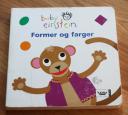Oh, the horrors you have to suffer through as a parent! Not only does the word «worry» take on a whole new meaning (I still check on the lass to see if she’s still breathing. She’s pushing two, now. Quite possibly I’ll still be doing it when she pushes eighteen), you are subjected to the strangest products designed to entertain your child. Unfortunately, mum and dad are still the child’s favourite toy, and so no matter how exciting a product may be you still tend to end up taking part in whatever activity it involves.
When it comes to books, you’d think I wouldn’t mind. Well, I do and don’t. I like reading with the lass, but like all toddlers she prefers to read the same books over and over and over, and though I reread books all the time, I tend to leave a little more than an hour between readings. I therefore attempt to achieve a nice mixture between reading the same books over and over again and discovering new ones. To that end we visited the library a few weeks ago. One of the books we took home was Baby Einsteins’ Former og farger (literally: Shapes and colours). The lass liked the illustrations. So far so good. Mum has some problems with it, though.

First: Shapes AND colours? Ok, so the shapes are very colourful and I can name them when reading, however the only actual mention of colour in the whole book is in relation to triangles when the goat says his horns are triangular and yellow. So colours? Not so much. The English version of the book seems to be called See and Spy Shapes, so that deals with part of the problem (i.e. the Norwegian editors committed a SNAFU). To continue in the gripy vein, though, why «See» AND «Spy»? Aren’t they synonyms in this context? Well, ok, children like repetition, I grant you, so we’ll move quietly on…

Second: Shapes. Another blooper – I assume – from the Norwegian editors. «Square» is translated «firkant». Not wrong, as such, just very imprecise. Firkant means, literally «four sides», i.e. it can refer to any quadrilateral. The correct translation, geometrically, for square, is «kvadrat». Had the squares been the only quadrilaterals in the book I might not have given it a second thought, but rectangles and diamonds are also given a mention. The fact that most Norwegians use firkant to mean square matters to me not one jot, it is still not the correct term.
Third: Shapes. Again. Stars, this time. I do not dispute that that is how we generally represent a star and that that shape is called star, but is it necessary to teach kids that that is what the stars in the night sky look like? Because, duh, they don’t.

Yes, I’m splitting hairs. I wouldn’t mind (much) if this was any old children’s board book. But by taking the name Einstein the company is asking for it. I don’t particularly want the lass to be the next Einstein, Curie, Fert or Grünberg, but I do try to avoid teaching her things that she will have to unlearn later.
We’ve handed the book back to the library, now, and I don’t think we’ll be buying a copy.
And on the subject of Einsteins, Little Einsteins is shown here at «barne-tv», the children’s hour on the state channel. I have several other gripes when it comes to that show, but they also contain these stupid, well, they can hardly be called mistakes, really, so lets call them unsound premises. The most recent example came just the other day when the gang were helping a pet called «Melody» find its ticket for the pet train. They stumble into Monets garden at some point and Melody ends up out in the lake, walking on the waterlily leaves. The gang need to rescue her, and do so with the help (or not) of the viewers by conducting Melody’s melody making her (him?) jump from leaf to leaf. Fine, you say? Well, yes, except the melody needs to be conducted quickly or slowly depending on how fast the leaves are moving up and down the lake. Anything strike you as odd in that scenario?
Of course it’s not the end of the world, but it’s so unneccesary. Especially in a show that purports to teach the kids things. Fine, so the kids may recognise Monets waterlilies next time they see them (though somehow I doubt it), but couldn’t they try to not in the process teach the kids things that are pure nonsense?


